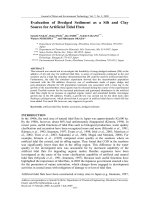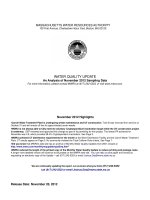sediment sampling
Bạn đang xem bản rút gọn của tài liệu. Xem và tải ngay bản đầy đủ của tài liệu tại đây (976.45 KB, 11 trang )
Information from stream
sediments
•
Measurement of concentration of
metals present (as solids) in
sediment
Gives information on:
1.
2.
3.
Background levels of contamination
Comparison of [M] between sites and
between depths in sediment at same
site
transport of sediment away from site of
contamination
Background levels of
contamination
Supposing we want to know how much
pollution has resulted from industrial activity
around the River Aire in Leeds.
We could sample the sediment and analyse
for metals such as Pb, Cd, Cu, etc
But we need to know the natural levels of
these elements.
So sample in another area of similar
Geology- get back ground level for that
environment.
Measuring variation in metal
concentration at a particular site
Mine site
Sampling above and
below the mine site
provides information on
1. Background [M]
2. Degree of contamination
3. Decay of [M] with distance
Map of a river
Sediment sampling- factors affecting
design of field technique
• Effect of Particle size of sample
All fine sediment
Fine sediment
plus cobble
Fine sediment represents all local rock types
The cobble represents a single rock type
Need to control particle size of sample
for analysis
Need to sieve sample prior to collection
Sediment sampling
technique : 2
• Where should we take a sediment
sample?
• Does it matter?
• It only matters if the nature of the
sediment varies between sampling sites –
over a short distance
• Why should we get a variation in river
sand at different points?
Sedimentary environments
Cobbles
larger boulders
midstream
The river sorts the sediment according to size
Formation of gravel bars
Section- gradient
change
Inside of bends
River widens
All changes from high- low energy
Sorting by density
• Minerals of different s.g. are segregated
by water action
Segregation occurs in 3 dimensions…
Distribution of heavy minerals in
fluvial sediments
Bedrock
% of heavy mineral grains in fine
sediment increases
Implications for sampling
Bulk chemistry of river sediment changes
with :
1. Place in the river
2. Depth in sediment
Need to standardise our sampling technique
If possible select:
•
Gravel bar on inside of bend or at edge
of river
•
Standard depth: 0.5 m.
Record details of the sampling site in your
field note book
How are the metals present?
In one of two forms:
1. As particulate minerals
2. Coatings on gravel/silt
1- assess through panning exercise
2- Measure through chemical analysis
So need to collect sample and split it to
enable us to do both.









